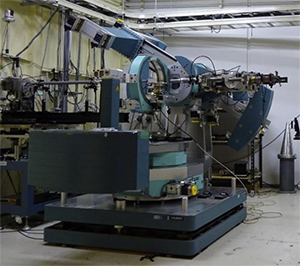BL13XU Multi-axis X-ray Diffractometer
問い合わせ番号
INS-0000001627
Multi-axis diffractometer
The multi-axis diffractometer system at BL13XU has been designed to meet diverse needs of academic and industrial users in X-ray diffraction and scattering analysis. It has a wide range of application from structure analysis of thin films, surface and interface to residual strain analysis and in-situ X-ray diffraction.
The diffractometer consists of eight axes: four basic (χ, φ, ω, 2θ) and four additional (2θz, θz, ωa, 2θa ) axes. A C-type χ cradle is adopted to get a wide scattering angle range (-20° to 160°) by avoiding dead angle. Samples can be put on a motorized XYZ or swivel stage not only for fine adjustment of the sample position but for mapping measurement of irradiated positions. We also have a He-gas-exchange sample chamber with a kapton dome (200 mm in diameter and 50 mm in thickness) to effectively reduce the background noise due to air-scattering around the sample.
In the optics, there are a total of three motorized four-quadrant slits: one is put at the upstream side of the diffractometer for adjustment of beam size and the other two are put on the detector arm for controlling collimation of detecting signal. An analyzer stage is installed on the detector arm (ωa, 2θa). The analyzer crystal, Si (111), Ge (111) and LiF (002) are provided. A solar slit can be set on the analyzer stage to improve the detection efficiency of scattering signals from an irradiation area broaden at the sample surface in grazing-incident X-ray scattering measurement. An attenuator autochanger has been installed for X-ray reflectivity spectra measurement of the dynamic range of around ~1010.
NaI scintillation counter is the standard detector at this beamline. In combination with two-dimensional pixel detector (PILATUS) or imaging plate (IP), etc., a variety of experiments including time-resolved X-ray diffraction measurement can be performed.
We use SPEC (Certified Scientific Software) as a control program. SPEC is a command line program where macro functions enables automatic multi-measurements. The macro functions can also be used for rapid sample exchange by controlling automatic adjustment of the sample position.
◆Features of the Equipment
Diffractometer
This diffractometer is a 6-axis diffractometer manufactured by HUBER, which consists of 4 axes around the sample (φ. &kai;, ω, ωz) and 3 detector axes (2θ, 2θz, 2θ2). As well, xs, ys, zs, rxs, rys axes can be attached around the sample and tha, ttha axes for mounting analyzer crystals can be installed on the detector axis.
Detector
Depending on the purpose of the experiment, any of the following detectors can be chosen. Both the 0-dimensional detector and the 2-dimensional detector PILATUS 300K can be installed on the detector axis.
・0-Dimensional Detector: NaI scintillation detector (OKEN)
LaBr3 scintillation detector (FMB oxford)
・1-Dimensional Detector: 6-Fold MYTHEN (dectris)
・2-Dimensional Detector: PILATUS 100K, 300K, 2M (dectris)
Control Software
SPEC (Certified Scientific Software)is used to control the beamline and the diffractometer.
X-ray Energy
The standard SPring-8 undulator and standard double crystal monochromator (Si (111/311) plane) is used. The available X-ray energy ranges from 5.0~72 keV.
Beam Size
The beam size changes depending on the measurement objectives.
The maximum beam size is approximately 1.0 mm wide by 0.7 mm high.
The minimum beam slit size: approximately 30 µm × 30 µm
The minimum beam size by Fresnel Zone Plate: Approximately 3 µm × 10 µm
Beam Intensity
12.4 keV, with a beam size length of 30 µm and width 400 µm (slit configuration) of approximately 5.0 × 1011 photons/sec
Other
A multi-axis diffractometer with almost the same specifications as this multi-axis diffractometer is installed in the second hatch of the BL19B2, which shares equipment accessories and control environments. Depending on the purpose of the experiment, you can select an inserted light source (BL13XU) and a bending magnet light source (BL19B2).
◆Equipment accessories
Automated stage for sample alignment (installed on the multi-axis diffractometer phi-axis)
zs-axis, xs-axis, ys-axis, rxs-axis, rys-axis
The zs-axis is mounted on the multi-axis diffractometer phi-axis, and various automated stages are installed on the zs axis according to the experiment.
Sample Environment
・Sample Heating Equipment(Reflection configuration): Anton Paar DHS1100 (Room Temperature to 1100 °C)
・Sample Cooling and Heating Equipment(Reflection configuration): Anton Paar DCS500 (-180 °C to 500 °C)
・Tension Test Machine : Maximum tension load 2 KN, same length 3 cm × width 1 cm × thickness 0.5 mm.
Detector
・0-Dimensional Detector: NaI scintillation detector (Photon application)
LaBr3 scintillation detector (FMB oxford)
・1-Dimensional Detector: 6-fold MYTHEN (dectris)
・2-Dimenstional Detector: PILATUS 100K (dectris)
PILATUS 300K (dectris)
PILATUS 2M (dectris)
Detector axis optical systems (when using a 0-dimensional detector)
・Double slit
・Solar Slit
・Analyzer Crystal
X-ray focusing element
・Zone Plate
・Refractive Lens
◆Contact
Tomoyuki KOGANEZAWA (koganeza@spring8.or.jp)
